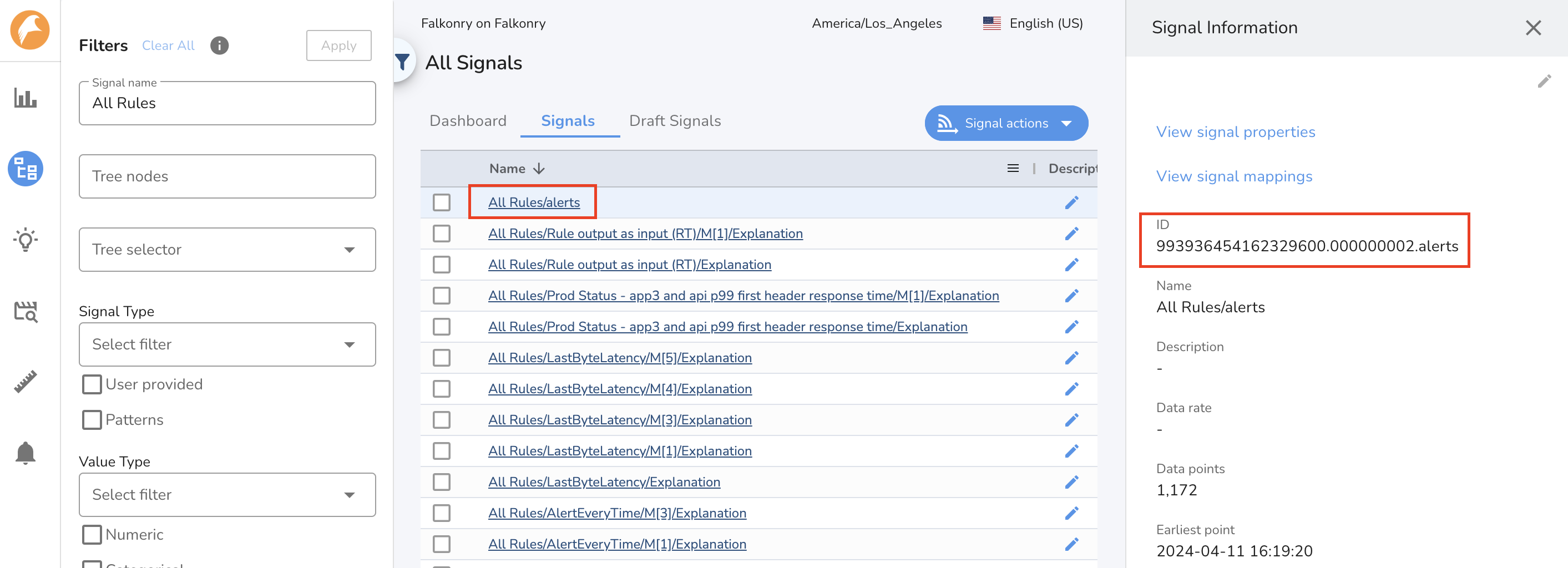Custom Integration with Falkonry Rules¶
To integrate with alerts generated by Falkonry Rules to perform condition-based actions, you can use Falkonry APIs. Here is a step-wise example on how to work with Falkonry APIs.
Step 1: Understanding Rules and the output signals
Each Falkonry Rule produces three types of output which are
assessment, alert and explanation output. Each of these are represented as
Falkonry generated signals.
| Rule Output Type | Falkonry Generated Signal Name |
|---|---|
| Assessment | <rule_name>/rule - contains rule output each time rule is assessed. Data value true means the rule condition was true point in time. |
| Alert | <rule_name>/alert - contains alerts from a specific rule. All Rules/alerts - contains alerts from across all rules. |
| Explanation | All Rules/<rule_name>/Explanation - contains explanation data across all signals that are input to a rule. <rule_name>/Explanation-<signal_name> - contains explanation data for a specific signal that is input to a rule. |
Step 2: Getting alert signal ID
Go to Signal Manager and search for the alert signal. You could use the
All Rules/alerts signal ID for fetching alerts from across
all the rules.

Step 3: Fetching alerts using the alert signal ID
Use :ref: [Alerts API \<Get Alerts>]{.title-ref} to fetch the alerts. You can poll the API to get recent alerts every 5 minutes. For time critical alerts, you can poll every 1 minute.
import requests
import time
TOKEN = '<token>'
HEADERS = {'Authorization': f'Bearer {TOKEN}', 'Accept': 'application/json'}
while True:
# fetch alerts across all the rules
end_time = time.time() * 1000000000 # time in nanoseconds
start_time = end_time - (5 * 60 * 1000000000) # now - 5m in nanoseconds
URL = 'https://app3.falkonry.ai/api/1.2/data/accounts/<account_id>/connectedsources/<rule_alert_ID>/raw_data?start=' + start_time + '&end=' + end_time
alerts = requests.get(URL, headers=HEADERS)
print(alerts.json())
time.sleep(5*60) # sleep for 5 minutes
Step 4: Getting rule configuration and explanation signal ID using rule ID
Use Signals API <Get Signals List> to
get the explanation signal ID for the specific rule.
for alert in alerts.json():
# get rule name and description using rule ID
URL = 'https://app3.falkonry.ai/api/1.2/accounts/<account_id>/assessments/' + alert["signal"]
response = requests.get(URL, headers=HEADERS)
rule = response.json()
# get rule configuration
URL = 'https://app3.falkonry.ai/api/1.2/accounts/<account_id>/assessments/' + alert["signal"] + '/models?type=RULE&isCommonModel=true&offset=0&limit=1'
response = requests.get(URL, headers=HEADERS)
ruleConfiguration = response.json()
# get explanation signal ID using rule name
signal_name = 'All Rules/' + rule["name"] + '/Explanation'
URL = 'https://app3.falkonry.ai/api/1.2/accounts/<account_id>/connectedsources?sourceName="' + signal_name + '"&offset=0&limit=1'
response = requests.get(URL, headers=HEADERS)
explanation_signal = response.json()[0]
# fetch explanation data using explanation signal ID
URL = 'https://app3.falkonry.ai/api/1.2/data/accounts/<account_id>/connectedsources/' + explanation_signal["id"] + '/raw_data?start=' + start_time + '&end=' + end_time
explanation_data = requests.get(URL, headers=HEADERS)
Step 5: Getting signal organization information using signal ID
Use Signals API <Get a Signal> to get
signal object. The signal object has the tree assignment information as
layouts. This can be used to identify the asset and equipment
information.
for eachSignal in explanation_data.json():
if eachSignal["value"] == True:
# get signal information using signal ID
URL = 'https://app3.falkonry.ai/api/1.2/accounts/<account_id>/connectedsources/' + eachSignal["signal"]
signal = requests.get(URL, headers=HEADERS)
print(signal.json())
Step 6: Working with chained rules
If case the input to the rule is output of another rule, the signal ID in the step 5 is the rule assessment signal ID. To get the explanation data for the this rule, use the Rules API to get the rule name and then use the Signals API to get the explanation signal ID.
for eachSignal in explanation_data.json():
if eachSignal["value"] == True:
# get rule name from the assessment signal
URL = 'https://app3.falkonry.ai/api/1.2/accounts/<account_id>/connectedsources/' + eachSignal["signal"]
rule_assessment = requests.get(URL, headers=HEADERS)
rule_name = rule_assessment.json()["sourceName"].replace("/rule", "")
# get explanation signal ID using rule name
signal_name = 'All Rules/' + rule_name + '/Explanation'
URL = 'https://app3.falkonry.ai/api/1.2/accounts/<account_id>/connectedsources?sourceName="' + signal_name + '"&offset=0&limit=1'
response = requests.get(URL, headers=HEADERS)
explanation_signal = response.json()[0]
# fetch explanation data and signal information using signal ID as explained in *step 5*.